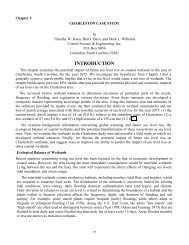A GEM Detector System for an Upgrade of the CMS Muon Endcaps
A GEM Detector System for an Upgrade of the CMS Muon Endcaps
A GEM Detector System for an Upgrade of the CMS Muon Endcaps
Create successful ePaper yourself
Turn your PDF publications into a flip-book with our unique Google optimized e-Paper software.
11 Summary <strong>an</strong>d conclusion<br />
Based on <strong>the</strong> results <strong>of</strong> <strong>the</strong> detailed R&D work presented here, we conclude that a radiation-toler<strong>an</strong>t <strong>GEM</strong> detector<br />
system represents a desirable <strong>an</strong>d viable option <strong>for</strong> upgrading <strong>the</strong>1.6 < |η| < 2.4 region <strong>of</strong> <strong>the</strong> <strong>CMS</strong> muon endcap<br />
system <strong>for</strong> <strong>the</strong> era <strong>of</strong> <strong>the</strong> high-luminosity LHC. Adding <strong>the</strong> <strong>GEM</strong> subsystem improves momentum resolution<br />
<strong>for</strong> high-pT endcap muons in <strong>the</strong> TeV region <strong>an</strong>d increases <strong>the</strong> robustness <strong>of</strong> <strong>the</strong> muon trigger by providing <strong>an</strong><br />
independent second trigger path <strong>for</strong> <strong>the</strong> <strong>for</strong>ward muon region. Trigger turn-on curves will be much sharper <strong>for</strong><br />
<strong>the</strong> <strong>GEM</strong> system th<strong>an</strong> <strong>for</strong> <strong>the</strong> originally pl<strong>an</strong>ned RPC system. These attributes <strong>of</strong> <strong>the</strong> proposed <strong>GEM</strong> system will<br />
streng<strong>the</strong>n <strong>the</strong> ability <strong>of</strong> <strong>CMS</strong> to control its muon trigger rates in <strong>the</strong> ever more challenging running environments<br />
<strong>of</strong> <strong>the</strong> future.<br />
Extensive prototyping has demonstrated that <strong>the</strong> step from small prototypes to full-size <strong>GEM</strong> chambers as needed<br />
<strong>for</strong> <strong>CMS</strong> is clearly feasible. The full-size prototypes achieve <strong>the</strong> required efficiencies <strong>an</strong>d resolutions. Integration<br />
<strong>an</strong>d installation studies show that <strong>the</strong> <strong>GEM</strong> chambers c<strong>an</strong> indeed be integrated into <strong>the</strong> given <strong>CMS</strong> high-η envelope.<br />
Our studies indicate that <strong>the</strong>re are no known show-stoppers with respect to needed services, i.e. cooling, cabling,<br />
<strong>an</strong>d gas distribution. A first design <strong>of</strong> on- <strong>an</strong>d <strong>of</strong>f-detector electronics <strong>for</strong> <strong>the</strong> readout <strong>of</strong> <strong>the</strong> <strong>GEM</strong> detector system<br />
addresses <strong>the</strong> major readout <strong>an</strong>d trigger concerns. This design makes much use <strong>of</strong> ongoing generic electronics<br />
developments <strong>for</strong> <strong>the</strong> LHC upgrades within <strong>the</strong> community.<br />
The ground work <strong>for</strong> launching into industrial <strong>GEM</strong> production has been laid. The projected chamber production<br />
<strong>an</strong>d infrastructure schedule <strong>an</strong>d milestones will allow <strong>the</strong> system to be installed during <strong>the</strong> second long LHC<br />
shutdown LS2 (currently <strong>an</strong>ticipated <strong>for</strong> 2017/2018). Budget estimations <strong>an</strong>d resources outlay show that two full<br />
<strong>GEM</strong> stations (GE1/1 <strong>an</strong>d GE2/1) could be produced <strong>an</strong>d commissioned at <strong>an</strong> equipment cost <strong>of</strong> 7.5 MCHF. An<br />
org<strong>an</strong>isational structure is well in place <strong>for</strong> <strong>the</strong> multi-institutional collaboration that is proposing to take on this<br />
upgrade project.<br />
Consequently, we conclude that this project is ready to move <strong>for</strong>ward <strong>an</strong>d request that this proposal <strong>of</strong> a “<strong>GEM</strong><br />
detector system <strong>for</strong> <strong>an</strong> upgrade <strong>of</strong> <strong>the</strong> <strong>CMS</strong> muon endcaps” be approved. This will allow <strong>the</strong> project to be integrated<br />
into <strong>the</strong> <strong>of</strong>ficial <strong>CMS</strong> upgrade program, which in turn will allow <strong>the</strong> participating institutions to approach <strong>the</strong>ir<br />
respective national agencies with funding requests <strong>for</strong> <strong>the</strong> project.<br />
Acknowledgment This work has partly been per<strong>for</strong>med in <strong>the</strong> framework <strong>of</strong> <strong>the</strong> RD51 Collaboration. The authors<br />
that are members <strong>of</strong> <strong>the</strong> <strong>CMS</strong> Collaboration would like to explicitly th<strong>an</strong>k <strong>the</strong> RD51 Collaboration <strong>for</strong> its<br />
continuous support <strong>of</strong> this work, <strong>for</strong> <strong>the</strong> m<strong>an</strong>y fruitful discussions, <strong>for</strong> <strong>the</strong> close collaboration during <strong>the</strong> test beam<br />
campaigns <strong>an</strong>d <strong>for</strong> dedicating part <strong>of</strong> <strong>the</strong>ir lab space at CERN to this project.<br />
79
















